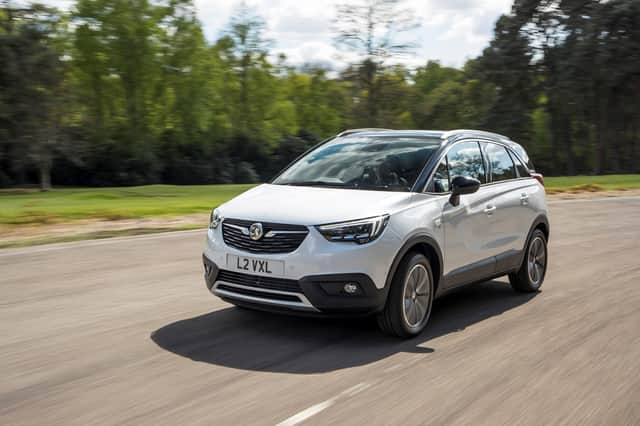MOTORS REVIEW: Vauxhall Crossland X


I get that feeling quite often when I tackle the Double Trouble Chocolate Fudge Cake at Uncle Sam’s burger bar on Ecclesall Road, Sheffield (other burger bars are available).
You can certainly have too much of a good thing I tell myself as I hobble back to the car, stomach bulging.
The thing is I love it… And I always go back for more.
Advertisement
Hide AdAdvertisement
Hide AdThere was a sense that Vauxhall might have gotten a little greedy in its taste for SUVs when I recently drove the Crossland X.
Seeking to emulate the success of its Mokka, which found 19,233 UK customers in the first half of 2017 alone, the Crossland is the latest addition to a range of Vauxhall SUVs which will also include a larger Grandland X model by the end of the year.
The trouble with the latest addition is that it feels very close in size and feel to its established and recently- updated stablemate.
Vauxhall reasons that the Mokka is more of a traditional rugged SUV where the Crossland is more spacious and family friendly.
Advertisement
Hide AdAdvertisement
Hide AdWhile the Mokka is the larger of the two, the Crossland features a larger boot (410l), which is 54-litres up on the Mokka in its smallest guise and a full 164-litres at full stretch thanks to a sliding rear bench (410 to 520 litres), but elsewhere just 65mm divides the pair in length, 39mm in width and 62mm in height.
Prices for the Crossland start at £16,555, compared to the Mokka’s £18,455, but that still makes it more expensive — at the range’s entry point — than the entry-level Nissan Juke, Renault Captur or Suzuki Vitara.
Vauxhall developed the Crossland in partnership with Peugeot and Citroen-owning PSA Group in a deal which pre-dated the French manufacturer’s recent acquisition of the British brand and its Opel counterpart in Germany.
As a result, it features PSA engines in the form of a 1.2-litre turbocharged petrol engine in 80bhp, 108bhp and 128bhp guise and a 1.6-litre turbodiesel available with 98bhp or 118bhp.
Advertisement
Hide AdAdvertisement
Hide AdTested here is the Crossland X Elite 1.2 130. Priced at £19,395 it sits mid-way through a range which includes SE, SE Nav, Techline Nav, Elite, Elite Nav and Ultimate specification options.
First things first. The Crossland is a fairtly handsome car without being remotely conspicuous.
Despite featuring the same contrasting roof arrangement as the popular Adam supermini, it really does look fairly anonymous to my eyes.
That said, I prefer its styling to that of the Mokka, particularly at the rear end where the more vertical-
Advertisement
Hide AdAdvertisement
Hide Adsided Crossland offers an appreciably larger glass section — allowing in more light — and the bonus of a more roomy-feeling interior.
Interior accommodation is pretty good, better than the equivalent Peugeot 2008 or Nissan Juke, for sure, and comparable to the Vitara.
Up front, the plastics feel a little on the cheap side, particularly the door inserts.
But while the general design and quality does not dazzle on first contact, Vauxhall’s OnStar connectivity service certainly proves a boon once again.
Advertisement
Hide AdAdvertisement
Hide AdBringing the ability to connect seven devices to a high-speed wi-fi hotspot the system also gives access to an emergency response and vehicle tracker facility in the event of an incident.
Smartphone users can also use the MyVauxhall app to view vehicle diagnostics, remotely lock and unlock the car, locate the car, honk the horn and flash the lights as well as downloading destinations to the in-car navigation system.
The sat-nav system was a £700 option on my test car, but was worth the investment, the system proving functional, if not the market’s slickest in appearance on-screen.
Elsewhere, the Elite specification boasts highlights such as 17-inch alloys, cruise control, parking cameras and dual-zone climate control.
Advertisement
Hide AdAdvertisement
Hide AdI drove PSA’s 1.2-litre turbocharged petrol engine most recently in the 2008 SUV and while it impressed with its urge back then, it felt just as perky but a little smoother in its delivery in the Crossland.
Vauxhall claims that the 1.2 turbo will achieve 55.4mpg and 116g/km CO2 emissions and the possibility of a 9.1-second dash to 62mph and 128mph top speed.
It feels good for the performance figures and served up close to 50mpg during my test according to the trip computer.
But while the Crossland felt assured through the corners, with fairly firm suspension, its light steering — handy while manoeuvring — offers little feedback.
Advertisement
Hide AdAdvertisement
Hide AdMore of an issue is a propensity for the suspension to feel under damped when speeds rise, bobbing gently but fairly continuously on faster B-roads and at motorway speeds, where wind noise from the A-pillar is also a little intrusive.
I identified the same issue when driving the new Insignia when not fitted with its optional adaptive suspension set-up.
While I spent most of my test driving alone, I can’t imagine this will be well received by travel sick-prone passengers.
In truth, the Crossland offers a good selection of technology, decent cabin space and a perky, economical engine but, overall, it lags behind the best in the class in other areas.
For now, it seems, Vauxhall can’t quite have its SUV cake and eat it…
First published August 11, 2017.